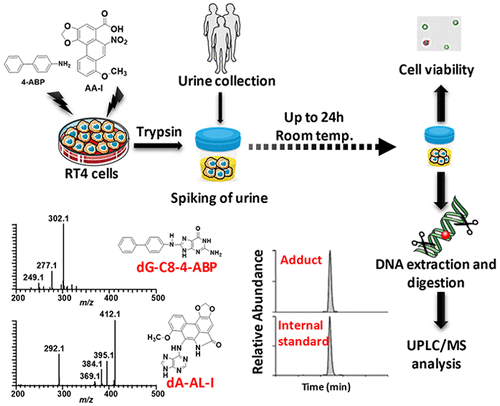当前位置:
X-MOL 学术
›
Anal. Chem.
›
论文详情
Our official English website, www.x-mol.net, welcomes your
feedback! (Note: you will need to create a separate account there.)
Method for Biomonitoring DNA Adducts in Exfoliated Urinary Cells by Mass Spectrometry
Analytical Chemistry ( IF 6.7 ) Pub Date : 2018-07-12 00:00:00 , DOI: 10.1021/acs.analchem.8b02170 Byeong Hwa Yun 1 , Medjda Bellamri 1 , Thomas A Rosenquist 2 , Robert J Turesky 1
Analytical Chemistry ( IF 6.7 ) Pub Date : 2018-07-12 00:00:00 , DOI: 10.1021/acs.analchem.8b02170 Byeong Hwa Yun 1 , Medjda Bellamri 1 , Thomas A Rosenquist 2 , Robert J Turesky 1
Affiliation

|
Tobacco smoking contributes to about 50% of the bladder-cancer (BC) cases in the United States. Some aromatic amines in tobacco smoke are bladder carcinogens; however, other causal agents of BC are uncertain. Exfoliated urinary cells (EUCs) are a promising noninvasive biospecimen to screen for DNA adducts of chemicals that damage the bladder genome, although the analysis of DNA adducts in EUCs is technically challenging because of the low number of EUCs and limiting quantity of cellular DNA. Moreover, EUCs and their DNA adducts must remain viable during the time of collection and storage of urine to develop robust screening methods. We employed RT4 cells, a well-differentiated transitional epithelial bladder cell line, as a cell-model system in urine to investigate cell viability and the chemical stability of DNA adducts of two prototypical bladder carcinogens: 4-aminobiphenyl (4-ABP), an aromatic amine found in tobacco smoke, and aristolochic acid I (AA-I), a nitrophenanthrene found in Aristolochia herbaceous plants used for medicinal purposes worldwide. The cell viability of RT4 cells pretreated with 4-ABP or AA-I in urine exceeded 80%, and the major DNA adducts of 4-ABP and AA-I, quantified by liquid chromatography–mass spectrometry, were stable for 24 h. Thereafter, we successfully screened EUCs of mice treated with AA-I to measure DNA adducts of AA-I, which were still detected 25 days following treatment with the carcinogen. EUCs are promising biospecimens that can be employed for the screening of DNA adducts of environmental and dietary genotoxicants that may contribute to the development of BC.
中文翻译:

通过质谱法对脱落尿细胞中 DNA 加合物进行生物监测的方法
在美国,约 50% 的膀胱癌 (BC) 病例是由吸烟引起的。烟草烟雾中的一些芳香胺是膀胱致癌物;然而,BC 的其他致病因素尚不确定。脱落尿细胞 (EUC) 是一种很有前途的非侵入性生物样本,可用于筛选损害膀胱基因组的化学物质的 DNA 加合物,尽管由于 EUC 数量较少且细胞 DNA 数量有限,对 EUC 中 DNA 加合物的分析在技术上具有挑战性。此外,EUC 及其 DNA 加合物必须在尿液收集和储存期间保持活力,以开发稳健的筛查方法。我们采用 RT4 细胞(一种分化良好的移行上皮膀胱细胞系)作为尿液中的细胞模型系统,以研究细胞活力和两种典型膀胱致癌物 DNA 加合物的化学稳定性:4-氨基联苯 (4-ABP)、烟草烟雾中发现的芳香胺,以及马兜铃酸 I (AA-I),一种在马兜铃草本植物中发现的硝基菲,在全世界范围内用于药用。用尿液中的4-ABP或AA-I预处理的RT4细胞的细胞活力超过80%,并且通过液相色谱-质谱法定量4-ABP和AA-I的主要DNA加合物,在24小时内稳定。此后,我们成功筛选了接受 AA-I 处理的小鼠的 EUC,以测量 AA-I 的 DNA 加合物,在用致癌物处理 25 天后仍然检测到。 EUC 是有前途的生物样本,可用于筛选可能有助于 BC 发展的环境和饮食遗传毒物的 DNA 加合物。
更新日期:2018-07-12
中文翻译:

通过质谱法对脱落尿细胞中 DNA 加合物进行生物监测的方法
在美国,约 50% 的膀胱癌 (BC) 病例是由吸烟引起的。烟草烟雾中的一些芳香胺是膀胱致癌物;然而,BC 的其他致病因素尚不确定。脱落尿细胞 (EUC) 是一种很有前途的非侵入性生物样本,可用于筛选损害膀胱基因组的化学物质的 DNA 加合物,尽管由于 EUC 数量较少且细胞 DNA 数量有限,对 EUC 中 DNA 加合物的分析在技术上具有挑战性。此外,EUC 及其 DNA 加合物必须在尿液收集和储存期间保持活力,以开发稳健的筛查方法。我们采用 RT4 细胞(一种分化良好的移行上皮膀胱细胞系)作为尿液中的细胞模型系统,以研究细胞活力和两种典型膀胱致癌物 DNA 加合物的化学稳定性:4-氨基联苯 (4-ABP)、烟草烟雾中发现的芳香胺,以及马兜铃酸 I (AA-I),一种在马兜铃草本植物中发现的硝基菲,在全世界范围内用于药用。用尿液中的4-ABP或AA-I预处理的RT4细胞的细胞活力超过80%,并且通过液相色谱-质谱法定量4-ABP和AA-I的主要DNA加合物,在24小时内稳定。此后,我们成功筛选了接受 AA-I 处理的小鼠的 EUC,以测量 AA-I 的 DNA 加合物,在用致癌物处理 25 天后仍然检测到。 EUC 是有前途的生物样本,可用于筛选可能有助于 BC 发展的环境和饮食遗传毒物的 DNA 加合物。
















































 京公网安备 11010802027423号
京公网安备 11010802027423号